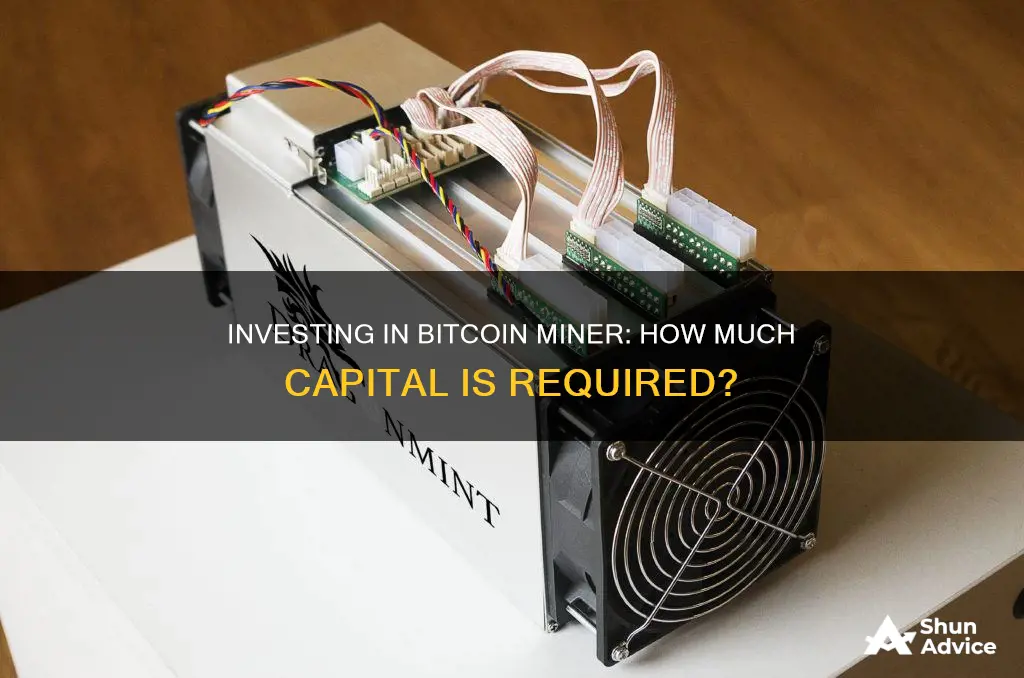
Bitcoin mining is an enticing prospect for many, given the cryptocurrency's high value. However, the reality is that it is a complex and costly endeavour. Bitcoin mining requires substantial hardware, software and electricity, with miners needing to invest in powerful computers and vast amounts of energy to successfully mine Bitcoin. The cost of the hardware alone can range from $1,000 to over $10,000, with ongoing electricity costs adding to the expense. Prospective miners should carefully consider the financial risks and perform a cost-benefit analysis before investing in Bitcoin mining.
| Characteristics | Values |
|---|---|
| Computer hardware | $1,000 to $10,000+ |
| Mining software | Free to download |
| Wallet | Free to $150 |
| Electricity costs | High |
| Time | 9 years to mine 1 bitcoin as of August 2021 |
What You'll Learn

Bitcoin mining hardware costs
ASIC Miners
Application-Specific Integrated Circuits (ASICs) are specialised devices built specifically for mining Bitcoin. They are the most powerful option available and typically range in price from $1,000 to over $15,000. The most popular ASIC miners include the Antminer S19 XP, the Whatsminer M53, and the DragonMint T1. These machines offer high hash rates and efficiency, but they come with a high upfront cost.
GPU Mining
GPU mining uses one or more graphics cards to mine Bitcoin. A typical setup might include a computer with multiple high-end graphics cards, which can be costly. While GPU mining is a popular choice for mining other cryptocurrencies, it may not be as effective for Bitcoin due to the lower processing power compared to ASICs.
CPU Mining
CPU mining utilises a computer's central processing unit, making it the most accessible method for beginners. However, CPUs have limited processing power and are therefore not recommended for Bitcoin mining. The chances of earning any rewards with CPU mining are slim due to the high competition from more powerful hardware.
Cloud Mining
Cloud mining involves renting computing power from a company to mine Bitcoin on your behalf. This option typically requires signing a contract and may not be profitable if cryptocurrency prices fall. While it may seem like a convenient choice, the potential profits are often outweighed by the maintenance and electricity costs deducted by the cloud mining company.
Mining Pools
Joining a mining pool allows miners to combine their resources and increase their chances of earning rewards. Most mining pools require participants to use either an ASIC miner or a GPU setup. By working together, miners can increase their collective hash rate and improve their odds of solving blocks. However, the rewards are shared among all participants, reducing the individual payout.
In addition to the hardware costs, it is important to consider the ongoing expenses associated with Bitcoin mining, such as electricity costs, cooling systems, and internet connection. These factors can significantly impact the profitability of mining operations.
Bitcoin Mining Companies: Worth Your Investment?
You may want to see also

Electricity costs
The energy consumption of the Bitcoin network is vast, with miners requiring large amounts of electricity to power their computers and cool their hardware. The exact amount of electricity used by a Bitcoin transaction can vary depending on demand, but it is estimated that a single transaction can use as much electricity as an average US household over nearly 48 days. The annual energy consumption of the Bitcoin network is projected to be around 95-130TWh, which is comparable to the energy consumption of entire countries such as Sweden or the Netherlands.
The high energy requirements of Bitcoin mining mean that electricity costs are a significant factor in determining the profitability of mining operations. Miners are incentivized to seek out the cheapest sources of power, and the low-cost energy available in certain US states, such as Texas and Washington, has made them attractive destinations for Bitcoin mining operations.
The type of energy used to power Bitcoin mining operations is also important. In the past, a significant proportion of Bitcoin mining was powered by renewable energy sources, such as hydropower in China during the wet season. However, following a crackdown on mining in China in 2021, many operations have moved to countries that rely more heavily on coal and gas-based electricity, such as the US and Kazakhstan. This shift has increased the carbon intensity of the electricity used for Bitcoin mining.
To reduce energy consumption and improve sustainability, some have suggested switching from the current "proof-of-work" method to a "proof-of-stake" method, which is much less energy-intensive. The ethereum network made this switch in September 2022, reducing its energy consumption by 99.95%.
Overall, the high electricity costs associated with Bitcoin mining can significantly impact the profitability of mining operations and have led to concerns about the environmental impact of the industry.
Apecoin: A Worthy Investment or Just Another Meme Coin?
You may want to see also

Bitcoin market value
Bitcoin is the world's first decentralised cryptocurrency, launched in 2009. It is a digital medium of exchange that exists solely online and is based on a decentralised peer-to-peer network and blockchain technology. Bitcoin has no physical token and operates as a digital currency.
Bitcoin's price is highly volatile. It is renowned for being the top-performing asset of any class, including stocks, commodities and bonds, over the past decade. In 2020, it traded as low as $4,107 and reached an all-time high of $75,830 in March 2024. As of August 2024, the live price of Bitcoin is around $59,866.94 per BTC/USD, with a market cap of $1.18 trillion.
Bitcoin mining is the process of creating new bitcoins by solving complex mathematical problems that verify transactions in the currency. When a bitcoin is successfully mined, the miner receives a predetermined amount of bitcoin. Bitcoin mining is a competitive process, with miners needing to invest in expensive hardware and software to stand a chance of earning bitcoin rewards.
The high costs and competition involved in Bitcoin mining mean that it is usually not profitable for individuals. Other risks of Bitcoin mining include price volatility, environmental concerns, and the potential for damage to electrical systems or overload on the power grid.
Due to the high costs and risks associated with Bitcoin mining, it may be more prudent to simply invest in Bitcoin directly.
The Pros and Cons of Investing in Bitcoin
You may want to see also

Mining pool choice
Joining a mining pool is a must for anyone who wants to get involved in Bitcoin mining. Mining pools are groups of cooperating miners that agree to share Bitcoin block rewards in proportion to their contributed mining hash power. Mining pools are desirable to the average miner as they make miner rewards more predictable.
There are about 20 major mining pools to choose from, and there are several questions you should ask when deciding which one to join.
Firstly, you should consider the pool's stability. This refers to whether the pool experiences any downtimes, which will affect your mining ability and profits. You should research the pool's history, including whether it has been vulnerable to DDoS attacks or experienced any lengthy downtime.
Secondly, you should review the pool's payout scheme and fees. Many pools use the pay-per-share (PPS) or the pay-per-last-n-shares (PPLNS) methods for their payment schemes. If the pool uses PPS, you receive a fixed amount per submitted share of work. Generally, you're paid when your share is submitted. PPLNS pays miners using a weighted system—the pool is paid when a block is mined, and the reward is divided among the pool.
Thirdly, you should look for transparency in the pool's operations. The mining pool operator must perform fairly to ensure transparency and trustworthiness among the pool's members. For instance, you should investigate whether the total hash rate declared at the pool level appears to be true and look for signs that the pool operators use lower payout schemes.
Finally, you should weigh the mining pool's size and power. In a mining pool, the number of coins mined over a period is proportional to the pool's computing power. In general, the more participants a pool has, the less time it takes to mine—pool size can equate to more or less computing time. A small pool of the latest ASIC miners can outperform a large pool of older or slower equipment. The combined hashrate of the mining pool is what determines which pool performs better.
Some of the biggest Bitcoin mining pools include Foundry USA, Antpool, F2Pool, ViaBTC, Binance Pool, Luxor, BTC.com, Poolin, and Braiins Pool.
Strategizing for Bitcoin's Crash: A Guide to Investing
You may want to see also

Bitcoin mining profitability
The profitability of Bitcoin mining is influenced by the following key factors:
- Cost of mining devices: ASICs, the most powerful option for mining Bitcoin, can range from $1,000 to over $15,000.
- Hash rate: The number of hashes per second the mining device can generate. A higher hash rate leads to higher earnings.
- Efficiency: The amount of energy a mining device consumes, expressed in watts per terahash. Lower energy consumption is more profitable.
- Electricity costs: Bitcoin mining is known for its high energy consumption, and cheap electricity is essential for profitable mining operations.
- Price of Bitcoin: Bitcoin's volatile price directly impacts mining profitability.
Given these factors, it is challenging for individuals to profit from Bitcoin mining. The high upfront costs of equipment and ongoing electricity expenses pose significant barriers. Additionally, the difficulty of mining increases over time, further reducing the likelihood of profitability.
To increase their chances of profitability, miners often join mining pools, where they combine resources and share rewards. However, this also means sharing any potential payouts, reducing the overall profit.
Overall, Bitcoin mining profitability is difficult to achieve and is highly dependent on a range of variables, including equipment costs, hash rates, electricity prices, and the volatile price of Bitcoin itself.
Should You Invest in Facebook's New Crypto Coin?
You may want to see also
Frequently asked questions
The cost of a bitcoin miner varies depending on the type of device you choose. Application-specific integrated circuits (ASICs) can cost anywhere from a few hundred dollars for a used model to tens of thousands of dollars for a new or hosted model. Graphics processing units (GPUs) are another option, with high-end graphics cards ranging in price from about $1,000 to $2,000.
In addition to the initial investment in hardware, bitcoin mining also requires significant electricity usage, which can result in high ongoing costs. The profitability of bitcoin mining depends on several factors, including electricity prices, the speed of your miner, and the market value of bitcoin.
The amount of money you can make from bitcoin mining depends on various factors, including the type of hardware you use, the hash rate, efficiency, and the price of bitcoin. Joining a mining pool can increase your chances of earning rewards, but it's important to note that bitcoin mining may not be profitable for individuals due to the high competition and costs involved.
The biggest risk of bitcoin mining is the potential to lose money if you don't make back your startup costs. Additionally, bitcoin mining is energy-intensive and can be harmful to the environment. There are also safety concerns, as mining devices can damage electrical systems or overload the power grid if not properly managed.
To get started with bitcoin mining, you'll need to purchase a miner, set up a crypto wallet, and join a mining pool. You'll also need to consider the location where you'll set up your miner, ensuring adequate air circulation and access to a 220V outlet.







